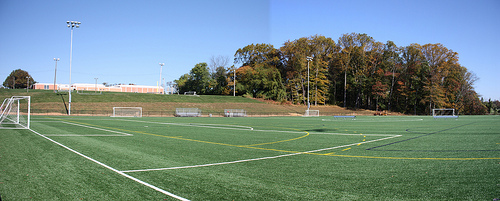Soccer Field Lines and Markings
Posted by admin on Jan 19th 2022
Soccer Field Lines and Markings

Even serious soccer fans might sometimes get confused and wonder what some of the lines and markings on the pitch actually stand for. Every level of soccer uses similar markings, although the size of the fields themselves may vary. These markings inform the players and referees whether the ball is in bounds or out of bounds, and which areas are legal for the goalie to use hands.
Lines and Markings
What are the different lines on a soccer field?
On a rectangular field, the long edges are referred to as touchlines, and any time that the ball is kicked, headed or rolls across these lines, a player on the team that did not touch the ball last will throw the ball in to put it back in play. The short edges of the rectangle are called the goal lines. Anytime the ball crosses a goal line, if it was touched last by a player on defense, an offensive player will take a corner kick from the area within a corner arc to inbound the ball. If the last touch was by an offensive player, the goalie inbounds the ball with a goal kick.
The large rectangle in front of each goal is the penalty box, with a forward edge that is 18 yards away from the goal line. Each penalty box contains within it a smaller rectangular box that extends 6 yards out from the goal line. The goalkeeper must place the ball somewhere within this goal area when performing a goal kick.
Rules and Plays
What is a quick explanation to the rules of soccer?
When the team without the ball commits a foul, and that foul is inside its own penalty box, the referee awards a penalty kick to the offense. Penalty kick marks are 12 yards from the goal line and in the middle of the field. When the official awards a penalty kick, or a "PK," a player will shoot from here. The rest of the players must wait outside the penalty arc, a small arc at the forward edge of the penalty box that is there to aid referees in making sure that no players other than the kicker are closer than 10 yards to the ball.
Finally, the center circle of a soccer pitch is where the match begins. One team kicks off, and both teams have to remain on their respective sides of the midfield line. The center circle, which has a radius of 10 yards, marks off the area that the team without the ball is restricted from entering until any player touches the ball.

